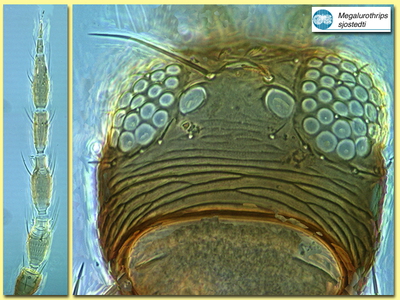Figures
Fig. 1 Antenna and head (dorsal)
Fig. 2 Fore and hind wing
Fig. 3 Metanotum
Fig. 4 Tergite VIII (female)
Fig. 5 Sternite VII (female)
Species
Megalurothrips sjostedti Trybom
Biology
Breeding only in the flowers of legumes, including a wide range of herbs and trees.
Distribution
Found only in Africa, where it is widespread.
Recognition
Large dark thrips with dark forewings that are pale at the base and frequently with a pale area sub-apically. Antennae 8-segmented, III & IV with sense cone forked. Head with one pair of setae in front of fore ocellus, and one pair of long setae arising between the fore and hind ocelli. Pronotum with 2 pairs of long posteroangular setae, also one prominent pair laterally and one pair at the anterior angles. Forewing with setal row on first vein interrupted near apex. Abdominal tergite VIII with an irregular group of microtrichia anterolaterally, posterior margin with a short comb that is widely interrupted medially. Sternites without discal setae; sternite VII with all setae at posterior margin. Male tergite IX with one pair of small seta-like tubercles on posterior margin; sternites without glandular areas.
Related species
The seven other species in this genus, all of which also live only in the flowers of legumes, are found from Asia to the Pacific. One of these species, M. usitatus, is common in the tropical parts of Australia. A further species that used to be placed in this genus is the citrus pest, Pezothrips kellyanus Bagnall (Mound & Gillespie, 1997), but this has few setae on the forewing first vein.






